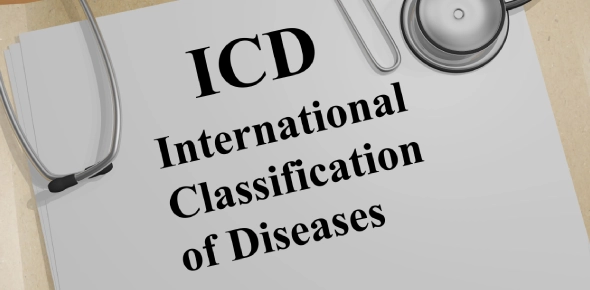Medical Coding Quiz On Diseases Of The Circulatory System (I00-i99)
-
Patient has stage 3 chronic kidney disease. They are admitted with acute on chronic diastolic congestive heart failure which is hypertensive in nature:
-
I10, N18.3, I50.21, I50.22
-
113.0, I50.33, N18.3
-
I12.9, N18.3, I50.21, I50.22
-
I11.9, I50.33, N18.3
-
This Medical Coding Quiz focuses on diseases of the circulatory system (I00-I99), assessing knowledge in coding conditions like hypertension, chronic kidney disease, and various heart failures using ICD-10 standards. It's designed for healthcare professionals to enhance accuracy in medical documentation.

Quiz Preview
- 2.
The patient is being treated for bilateral retinopathy due to labile hypertension:
-
H35.033
-
H35.103
-
H35.033, I10
-
H35.031, H35.032, I10, X58.XXXD
Correct Answer
A. H35.033, I10Explanation
Hypertensive Retinopathy
Subcategory H35.0, Background retinopathy and retinal vascular changes, should be used with a code from category 110 -115, Hypertensive disease to include the systemic hypertension. The sequencing is based on the reason for the encounter.Rate this question:
-
- 3.
Atherosclerosis of left leg autologous bypass graft with intermittent claudication:
-
I70.419
-
I70.411
-
170.412
-
I70.413
Correct Answer
A. 170.412 -
- 4.
Patient suffered an embolic stroke in the left middle cerebral artery. She presented with hemiplegia affecting right side and aphasia due to stroke:
-
I63.512, I69.354
-
163.412, R47.01, G81.91
-
I69.320, I69.352
-
I69.320, I69.352, I63.512
Correct Answer
A. 163.412, R47.01, G81.91Explanation
Often, a patient is admitted with a stroke with deficits. These deficits are often gone by the time the patient is discharged. Any deficits that a patient exhibits from the stroke, whether present at discharge or not, should be assigned codes.Rate this question:
-
- 5.
The patient was admitted with acute renal failure. The patient also has diagnoses of benign hypertension and chronic kidney disease, stage 3:
-
I10, N17.9, N18.9
-
I12.9, N18.3, Z99.2
-
N18.3, N17.9, I13.10
-
N17.9, 112.9, N18.3
Correct Answer
A. N17.9, 112.9, N18.3Explanation
Hypertensive Chronic Kidney Disease
Assign codes from category 112, Hypertensive chronic kidney disease, when both hypertension and a condition classifiable to category N18, Chronic kidney disease (CKO), are present. Unlike hypertension with heart disease, ICD-10-CM presumes a cause-and-effect relationship and classifies chronic kidney disease with hypertension as hypertensive chronic kidney disease.
The appropriate code from category N18 should be used as a secondary code with a code from category 112 to identify the stage of chronic kidney disease.
See Section I.C. 14. Chronic kidney disease.
If a patient has hypertensive chronic kidney disease and acute renal failure, an additional code for the acute renal failure is required.Rate this question:
-
- 6.
Patient has hypertension due to Cushing's disease:
-
E24.9, I15.1
-
E24.8, I10
-
I13.0, E24.9
-
E24.9, I15.2
Correct Answer
A. E24.9, I15.2Explanation
The correct answer is E24.9, I15.2. This answer indicates that the patient has both Cushing's disease (E24.9) and hypertension (I15.2). Cushing's disease is a condition caused by excessive production of cortisol, which can lead to hypertension. Therefore, it is likely that the patient's hypertension is a result of their Cushing's disease.Rate this question:
-
- 7.
Patient is admitted with an STEMI of the anterolateral wall. During initial recovery in the hospital (within 3 weeks of initial AMI), the patient experiences a subsequent NSTEMI:
-
121.09, 122.2
-
I21.4, I22.0
-
I22.2, I21.09
-
I22.8, I21.19
Correct Answer
A. 121.09, 122.2Explanation
Subsequent acute myocardial infarction
A code from category I22, Subsequent ST elevation (STEMI) and non ST elevation (NSTEMI) myocardial infarction, is to be used when a patient who has suffered an AMI has a new AMI within the 4 week time frame of the initial AMI. A code from category I22 must be used in conjunction with a code from category 121. The sequencing of the I22 and 121 codes depends on the circumstances of the encounter.Rate this question:
-
- 8.
The patient was admitted with left-sided hemiplegia due to a cerebrovascular accident. The patient has a history of previous CVA with residual facial droop:
-
I69.354, I69.392, Z86.73
-
I63.9, G81.94, I69.392
-
I69.354, Z86.73, I69.992
-
R29.810, G81.94, I63.9, Z86.73
Correct Answer
A. I63.9, G81.94, I69.392Explanation
Codes from category 169 with codes from 160-167
Codes from category 169 may be assigned on a health care record with codes from 160-167, if the patient has a current cerebrovascular disease and deficits from an old cerebrovascular disease.
Codes from category 169 and Personal history of transient ischemic attack (TIA) and cerebral infarction (Z86.73)
Codes from category 169 should not be assigned if the patient does not have neurologic deficits.Rate this question:
-
- 9.
Patient is admitted to the hospital with chest pain. After testing, it is determined that the patient has suffered a NSTEMI. Patient is discharged home. Two weeks later, patient returns to the hospital with severe chest pain. It is now determined that the patient has suffered a STEMI of the inferolateral wall:
-
I21.19, I22.2
-
I22.1, I22.8
-
122.1,121.4
-
I21.19, I22.8
Correct Answer
A. 122.1,121.4Explanation
ICD-10-CM also has codes for subsequent Mis that occur within 28 days of the previous Ml. The code category assigned for these subsequent Mis is 122. Category 122 can never be assigned without a code from 121 for the original. The sequencing of these codes is dependent upon the conditions of the admission to the hospital.Rate this question:
-
- 10.
Hypertension due to periarteritis nodosa:
-
I10, M30.0
-
I11.9, N30.0
-
M30.0.115.8
-
M30.0, I15.2
Correct Answer
A. M30.0.115.8Explanation
Hypertension, Secondary
Secondary hypertension is due to an underlying condition. Two codes are required: one to identify the underlying etiology and one from category 115 to identify the hypertension. Sequencing of codes is determined by the reason for admission/encounter.Rate this question:
-
Quiz Review Timeline (Updated): Mar 22, 2023 +
Our quizzes are rigorously reviewed, monitored and continuously updated by our expert board to maintain accuracy, relevance, and timeliness.
-
Current Version
-
Mar 22, 2023Quiz Edited by
ProProfs Editorial Team -
Apr 01, 2017Quiz Created by
Naushad207
ICD 10 Quiz Questions And Answers
The ICD Quiz is an excellent way to test your knowledge of the International Classification of Diseases (ICD). This quiz is designed for students and professionals in healthcare,...
Questions:
25 |
Attempts:
24919 |
Last updated:
Jan 22, 2025
|
International Statistical Classification Of Diseases ICD-10
Take this fun, quick quiz that tests basic knowledge of ICD-10.
Questions:
5 |
Attempts:
715 |
Last updated:
Mar 21, 2023
|
What Is ICD-10 Quiz?
Take this fun, quick quiz that tests basic knowledge of ICD-10.
Questions:
5 |
Attempts:
1432 |
Last updated:
Mar 21, 2023
|
CARDIOLOGY CME - HRUDOY 2019
CARDIOLOGY CME - HRUDOY 2019 is a specialized quiz designed to assess knowledge in cardiology, focusing on conditions like angina, hypertension, and non-cardiac chest pain. It...
Questions:
30 |
Attempts:
337 |
Last updated:
Mar 20, 2023
|
CVS - AR (5)
This CVS - AR (5) quiz assesses knowledge on aortic regurgitation, covering causes, echocardiographic findings, treatment indications, and surgical criteria. It's designed for...
Questions:
5 |
Attempts:
118 |
Last updated:
Mar 20, 2023
|
Infective Endocarditis MCQ Questions And Answers
Do you understand what infective endocarditis is? Take this infective endocarditis quiz to see how much you know. Basically, infective endocarditis is an infection caused by...
Questions:
10 |
Attempts:
5888 |
Last updated:
Apr 25, 2024
|
 Back to top
Back to top








